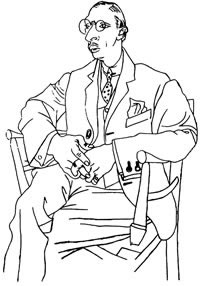Allegro
Bam! What was that sound?
Local 802 musicians reflect on what playing this awesome piece means to them
Volume 113, No. 5May, 2013
Part I: The Adoration of the Contractor
The Augurs of the Gig
Spring 2009: here I am, sitting on stage at Avery Fisher Hall, subbing with the great New York Philharmonic. Indeed a high honor. Without a doubt, one of the world’s finest orchestras. The stage is chock-full of instruments. I’m checking the score as I write this to verify my memory: Eight – count-em, eight – French horns, various drums, cymbals, tam-tam, triangle, tambourine, guiro, etc. etc. The Philharmonic has spared no expense and has hired extra strings, including me. Oh that Carl Schiebler; one of the best contractors in the business! I’m sitting WAAAY in the back, probably 12th double bass. What a sight. That puts me squeezed between the two sets of timpani. Oh Jeez, I hope I didn’t leave my earplugs in my instrument case, nope, here they are. Ach, dropped one. Got it. Whew! AACH! Dropped my rosin. How embarrassing.
These Philharmonic players are just so phenomenal, and they know this piece really well. I’ve only played it a couple of times since a disastrous outing in college, but now that I have a few decades of orchestral experience under my belt, how hard could it be?

Above, a sketch of Igor Stravinsky by Pablo Picasso, who designed the original costumes and sets of Stravinsky’s 1920 ballet “Pulcinella.” Picasso took the opportunity to make several sketches of the composer.
Procession of the Wisest Conductor:
The enigmatic Russian maestro Valery Gergiev strides to the podium. He lightly gestures a soft, magical downbeat. I feel like a little insignificant caboose back here as this giant freight train pulls out of the station.
It starts so really quietly and slowly. The bassoon solos in an almost uncomfortably high-sounding tessitura, but Judy LeClaire plays it so beautifully. How many wind entrances are there? There are 20 woodwind players? That is soooo cool. It’s hypnotizing the way Stravinsky draws you into his musical universe. The harmonic and rhythmic languages are almost primal.
Over at the New York City Ballet, where I am principal bassist, I have discovered that there are two widely separated categories of ballet music. Luckily, we don’t play much of Category One, which is some of the worst, mundane and forgettable stuff. Category Two contains pieces like “Swan Lake,” “The Nutcracker,” and “Romeo and Juliet,” which are just about the best music of any kind ever written. No piece better illustrates this latter category than Stravinsky’s monumental “The Rite of Spring.” The members of the NYC Ballet Orchestra are Stravinsky specialists, but surprisingly we’ve never tackled “The Rite.” That’s another reason I feel fortunate to have this chance with the Philharmonic.
Ritual of the Two Rival Tubas
BAM! What was that sound? I didn’t know an orchestra could play that loud! What instrument was that? Say, does a trumpeter or a trombonist play the bass trumpet? Wait, stop listening; pay attention to your own part. No, I have to listen. It’s too fascinating and engrossing. Where am I? Oh yeah, on page eleventeen or something. F-flat? That’s just another name for a D-double-sharp, which by any other name sounds as sweet. Open fifths sound so good with a giant bass section like this. Gergiev is SOOO far away. I can barely see his stubble beard and his toothpick-sized baton. Wait, he’s not using an ACTUAL toothpick, is he?
The first time I played this piece was in college about 33 years ago, which means that I can say that I’ve been playing it for a third of its life. Back then I remember thinking several times, “Please, God, let me count out this passage correctly!” Trying to count the time changes in “The Rite” is where I, for one, discover religion. I’ve always prided myself on being an excellent reader, but in Stravinsky, no matter how well you think you know certain pieces, when you least expect it a passage will just up and bite you.
Being under-rehearsed is the story of my career. Was that an actual chord or a cluster? (We bassist/composers instinctively need to keep track of the harmony.) Say, how would you ever fit all these instruments into an orchestra pit anyway? Maybe keep the orchestra on stage and put the dancers into the pit? Are those old ladies at this 11 a.m. matinee actually enjoying this cacophony? Yes, they are smiling broadly. Bless them anyway; there’d be no classical music in this country without them.
Part II: The Exalted Sacrifice of the Uniform Bowings
Twenty-second respite here. Relax…breathe. Uh-oh, it’s starting up loud and fast again; get counting, Ron. Will that second bass clarinet player notice my wrong note? Doesn’t matter, he’s just a sub too. Please, God, let me count out this passage correctly. Was there a change of bowing from the first stand that got lost in transit before reaching me six desks in the back? Can’t possibly see (then) principal bass Eugene Levinson’s bow arm. Can’t see him at all. Whoops, I’m committed. Feels like I’m up-bowing and down-bowing at the same time. Ohhhh! Thaaaat’s where John Williams borrowed that Star Wars bit from. How can anyone possibly dance to this? Say, am I going to get out of here in time to make my matinee at the ballet across the Lincoln Center Plaza? When am I ever going to get my lunch? Bread Soul Café once again.
Big, big, big 11/4 measure coming up: Awesome timpani/bass drum power! Reminds me how we hated that conductor so much in college. The orchestra conspired behind his back to play TWELVE hits, not eleven. I don’t think he ever figured it out. Ouch, did I just play only TEN quarter hits this time? Karma. Stravinsky bites again?
Mystic Circles of the Violin Scroll
Oh, that orchestra in college sure was an excellent-looking band. Can’t forget that. I’ve seen some darn unattractive choruses in my time. You know what I’m talking about. Speaking of movies, did you see “Coco Chanel and Igor Stravinsky,” that fictional-historical drama wherein Stravinsky gets naked, and looks as handsome and muscular as a matinee-idol? I swear I am not making this up! Anyway, during large sections of the movie, he is shown working at the piano (sometimes naked) on a revision of “The Rite.” The musical temperament of the movie is very well done. Made me realize how pianistic this piece actually is.
The Sacrifice of the Bow Hair
Wow! What an amazing, brutal sound. 5/8, 7/8, 5/8, 6/8. Still so fresh after 100 years. Gotta dig in harder and hit Greg Wylie for a re-hair tomorrow. These beat patterns are actually starting to make sense and feel natural. What would Bach think about this if he were alive today? Would his head explode? Even faster now, 5/16, 2/16, 3/16, 2/8; what a groove! Yeah, baby! Human sacrifice? Those zany Russian pagans! Last page now, 3/16, 3/16, 3/16, 2/16, 5/16, 3/4, DEAD STOP! Pause, just a hair longer, listen to the flutes go way up high…wait for it…watch for Gergiev’s final downbeat, here it comes…BOOM!!!
Ron Wasserman is the principal bassist of the New York City Ballet.

